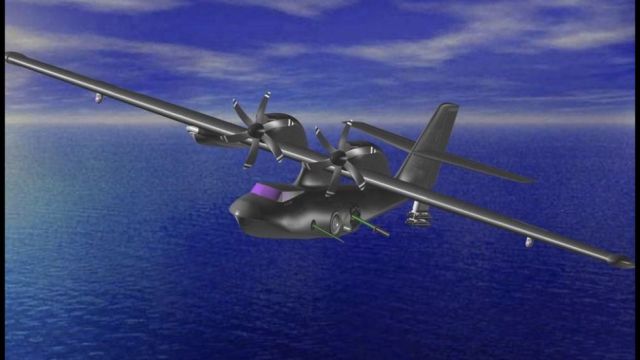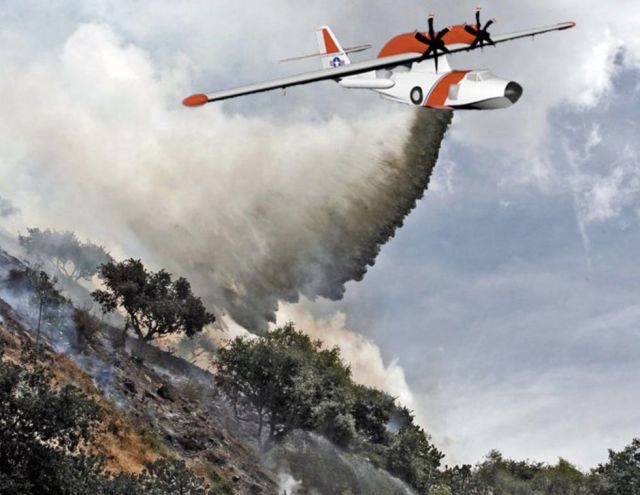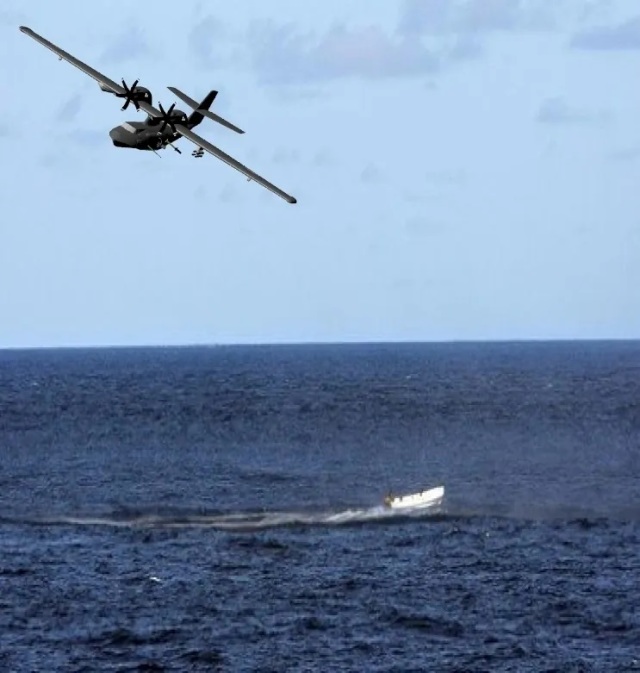A small American company Catalina Aircraft from Florida on July 25, 2023 announced a project to resume production of the famous flying boat of the 1930s-1940s Consolidated PBY Catalina in an updated form under the name Next Generation Amphibious Aircraft (NGAA) Catalina II. The updated Catalina II amphibious aircraft should be equipped with turboprop engines, improved wing mechanization and modern avionics and is offered for both civil and military applications.

The conceptual appearance of the military version of the turboprop amphibious aircraft Next Generation Amphibious Aircraft (NGAA) Catalina II of the American company Catalina Aircraft (c) Catalina Aircraft
The project is based on the fact that after the war, the original PBY Catalina in a demilitarized transport and passenger version (Model 28-5ACF) received an American civil FAA type certificate in connection with the use of these aircraft by the French airline Air France. Now Catalina Aircraft is the legal holder of the type certificate (last confirmed by the FAA in 2009) and the license rights to the aircraft, which repeatedly changed ownership in the post-war decades. Accordingly, according to Catalina Aircraft, the updated Catalina II will not require a new certification, but only additions to the existing type certificate. At the same time, the current type certificate gives the right to carry out passenger transportation, which no other seaplane on the market in the world has.
The Catalina flying boat was developed by the American aircraft company Consolidated Aircraft Corporation (as Model 28) initially for a competition for the US Navy aviation on a 1932 assignment and made its first flight in March 1935. Serial production of the aircraft was carried out in the United States by various manufacturers from 1936 to 1945. In total, according to the most accurate data, 4051 aircraft were built, of which 742 were manufactured under license in Canada (Canadian-made aircraft are known collectively as Canso) and 27 aircraft in the USSR (GST). The Catalina was operated by the US Armed Forces until 1957. In the post-war period, Catalina aircraft were operated both military and civilian in 41 countries, and 83 operators flew in the civilian version.
Catalina Aircraft Company was established in 2009 and was initially engaged in the restoration and maintenance of airworthiness and repair of the original PBY Catalina flying boats remaining in operation in the world and in the USA. It is reported that by the middle of 2023, there were from 14 to 17 Catalina and Canso flying aircraft in the world, at least seven more are in the process of being restored to flying condition. and dozens of planes are in storage or on display in museums. Catalina Aircraft has restored three aircraft to flying condition during its operation.
Now Catalina Aircraft declares that the NGAA Catalina II aircraft planned for production should be completely new-built machines and only the first prototype will be made on the basis of the old airframe, with the start of flight tests in 2025. Then the company intends to build six pre-production aircraft for the expanded test program - three military and civilian versions each. Deliveries of serial aircraft of new construction are promised from 2029. The company claims that it already has a start-up customer, which can be publicly announced at the end of 2023. Catalina Aircraft stated that it is considering several sites in the United States and one abroad (apparently in Canada) for the organization of serial production of aircraft.
According to the data provided by the developer, the Catalina II aircraft should be a complete amphibian with retractable landing gear, which, however, can be easily dismantled to reduce weight. Retractable floats will be installed on the wingtips.
The main change should be the replacement of two piston engines with new turboprop engines with five-bladed propellers. The type of the new engine is not reported, but, according to a number of media reports, they are probably planning new General Electric Catalyst, which in various modifications should have a take-off power from 1300 to 1600 hp. It is assumed that the military version of the aircraft will be equipped with a more powerful modification.
It is stated that the civilian version of the Catalina II will have a maximum take-off weight of 32 thousand pounds (14515 kg, other sources cite 16 thousand kg) and is capable of carrying 12 thousand pounds (5444 kg) of cargo or 34 passengers. The cruising speed should be 213 mph (343 km/ h), and the flight range should be more than 1,750 miles (2,816 km).
The military version should have a maximum take-off weight of 40 thousand pounds (18144 kg, other sources cite up to 20 thousand kg), a payload of up to 16 thousand pounds (7257 kg), a cruising speed of 230 miles per hour (370 km / h), and a flight duration of up to 19 hours with a maximum fuel reserve up to 2710 gallons (10258 liters). To improve seaworthiness, the military version is supposed to be equipped with a modified wing with enhanced mechanization, which will provide a low stall speed (71 miles per hour - 114 km / h) and take-off on a wave of up to 3 points (with a wave height of 0.5 to 1.25 m). Armament holders with a total weight of 2,500 pounds (1,133 kg) can be placed under each wing. Based on the military option, it is also proposed to create a fire-fighting option. The company also announces the possibility of creating an unmanned version of the aircraft.


The conceptual appearance of the turboprop amphibious aircraft Next Generation Amphibious Aircraft (NGAA) Catalina II in anti-fire (top) and military variants (c) Catalina Aircraft

(c) Catalina Aircraft
